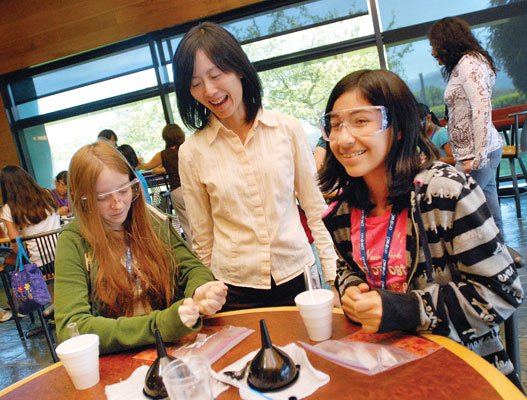A dozen girls squealed with a mixture of disgust and delight as
the goopy concoctions they had created dripped in sticky strings
from their fingertips. Standing on a chair, 13-year-old Haleigh
Nino won the friendly competition to see whose would stretch the
farthest
– hers made it to the floor.
A dozen girls squealed with a mixture of disgust and delight as the goopy concoctions they had created dripped in sticky strings from their fingertips. Standing on a chair, 13-year-old Haleigh Nino won the friendly competition to see whose would stretch the farthest – hers made it to the floor.
“This was definitely one of my favorite projects,” she said, holding up a blob of green glurch, a putty-like polymer made of borax, water, glue and food coloring. Extracting strawberry DNA – a pinkish liquid she carried home in a clear plastic vial – was a close runner up, she said.
Nino is one of six girls from Ascencion Solorsano Middle School to attend a free week-long day camp at the IBM Almaden Research Center in San Jose. Every day this week, the girls wound their way up a twisting road in the foothills of the Santa Cruz Mountains to the company’s research laboratory for a day of hands-on exploration.
The facility’s security gate and imposing lobby give a no-nonsense look from the outside. But inside, the classrooms echoed with the chatter and laughter of middle school girls building computers, experimenting with polymers and making ice cream out of liquid nitrogen.
“We’re looking to give these girls exposure and spark an interest in science, technology, engineering and math,” said Bob Martinez, the center’s outreach program manager. “We want to see more girls getting into (those fields). The numbers are low. Our whole objective is to get these young kids, many from minority populations, because they are the ones that don’t get the exposure. When you see the spark in their eyes, it’s truly rewarding.”
The camp is part of a partnership Solorsano has established with IBM, Solorsano science department chair Dawn O’Connor said. As an “IBM School,” Solorsano runs an after-school program with the help of a liaison from the company that introduces students to new, hands-on projects every week.
It’s in those hands-on projects that “science came alive” for O’Connor when she was her students’ age, she said. But with only 45 minutes during the day for class, it’s often the labs – which students tend to enjoy the most – that get cut short. For that reason, Solorsano’s after-school programs are invaluable, O’Connor said. About 35 students show up for the IBM program every week.
“It’s a huge commitment but we’re all passionate about science,” she said of her department. “And we have an administration that says ‘yes.'”
The IBM program is geared toward “the kids that maybe went unnoticed,” O’Connor said. “The kid with the really curious mind, the out-of-the-box thinker who may not have gotten that recognition in class or may not have had the funding to attend another summer camp. It’s the kid that has a bazillion and one questions.”
In exchange for one week of their summer vacation, the six girls selected for the day camp learned skills many students won’t acquire even as they move through their high school science courses.
“There are so many interesting things to learn about,” said Alison Day, 13, who plans to return as a team leader next year.
From more abstract ideas, such as how different molecules of a polymer bond together, to specific skills, such as how to solder together two pieces of metal to make a circuit board, “learning about this stuff is pretty cool because we get to do everything ourselves,” she said.
Fueled by the volunteer hours of dozens of self-dubbed “IBMers,” the camp’s organizers realized quickly that it’s the hand-on nature of the program that excites the students, Martinez said.
“We learned not to give any lectures,” he laughed. “Kids that usually don’t say a peep to their parents about school? Parents tell us that they won’t stop talking about camp.”
Another aspect that differentiates the camp from the classroom is that it’s all girls during this round. Six boys from Solorsano will attend the same camp, but not until August.
“It certainly gives girls that don’t have that extroverted personality a better opportunity to participate,” said John Day, an IBM employee, volunteer and father to Alison and Christina, 11 – who also attended the camp. At IBM, the diversity of the workforce “is tremendous,” with a long history of women engineers and scientists, Day said.
Though she doesn’t observe much of a disparity between boys and girls in her accelerated classes, O’Connor has noticed that girls in her mainstream class are more hesitant to raise their hands.
“Mostly girls are worried about what they’re looking like,” said Alison Day, who hopes to become either a lawyer or a marine biologist. “They’re not worried about that here.”
Though she’s not a proponent of gender-segregated schools, O’Connor has observed that boys and girls seem to think and reason differently. When problem solving in groups, “boys are much bolder risk-takers while girls tend to be more methodical, cautious,” she said. “The guys will raise their hands and shout out and they don’t care if they’re wrong.”
Teachers need to figure out ways to address different learning styles while giving all students an opportunity to advance, she said.
“We have to recognize that we have so much untapped talent,” she said. “We’re losing our competitive edge in technology and science.”
But for the six girls who spent the week exploring water-filtration systems, PCs and polymers up close, it’s simpler than that.
As 14-year-old Lauren Miller, picking a few pieces of glurch from her green-tinted fingers, put it: “I just like learning.”














